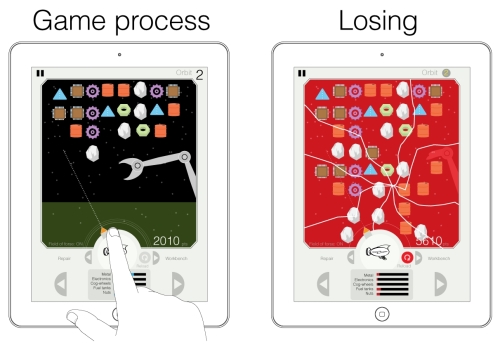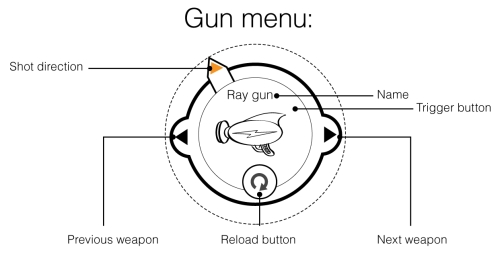Incredible, but the tile-matching mechanism can easily be combined with other complex genres, for example, with role-playing gameplay an element that can make the game truly personal to the player and increase his involvement in the process. Judge for yourself: in RPG, a player obtains achievements or trophies for each hard quest he is taken through; then, he can spend the experience points on some useful items, such as weapons and shields. Besides the glory adventures, there is also a day-by-day routine when the player performs ordinary actions to get some vital resources. A match-three puzzle, especially in the Shooting mode, can be pretty much the same: complex combinations of elements being found and eliminated are the quests and these give some unique rewards and many points, but low-value progressions are the routine tasks. The rewards are in the form of special types of weapons the player uses to shoot the tiles. The following is a screenshot from the 10000000 game, which combines scroll-based match-three gameplay with RPG adventure:

Among the popular examples of such symbiotic games for iOS, I can mention a project with an incredible name: 10000000 (http://eightyeightgames.com), created by EightyEight Games LTD, features interesting gameplay, story, and smart pixel artwork. Its main character travels through dungeons full of treasure and monsters. By resolving a match-three puzzle, a player may help the character to perform some actions; for instance, by finding the sequence of tiles consisting of at least three swords, he can make the hero hit an enemy.
Let's plan that type of game. For example, it can be a spiritual sequel to the card/board from the previous chapter; the story about the robots on asteroids continues. Let's give it a code name The lifeboat breakthrough. Here's the plot:
One of the robots successfully got in the space lifeboat, started the engine, and tried to leave the guileful asteroid. But suddenly, it received some unpleasant news. First of all, the lifeboat was not in perfect condition, and many nodes and components were almost broken. They worked on a wing and a prayer. Moreover, Murphy's Law prevailed; the level of fuel was very low and any minute the space vessel was going to fall down on the surface of the asteroid. Another "pleasant" discovery: there were hundreds fragments of the mother ship and rocks in space, which got stuck in the asteroid's gravity and looked like an impassable shell, covering the minor planet.
But the lead character did not lose his cool; he looked at the sky attentively and noticed that the fragments around the lifeboat might be not obstacles but lifesavers; there were many useful parts, which could help fix his space lifeboat. Also, there were many tanks of fuel. One of the advantages of the space lifeboat was special mechanical arms (since it was sometimes used as a repair vessel), so the robot on board could try to grab the fragments he needed. Using a workbench, he also could build various useful things, primarily weapons, which would help him to destroy dangerous rocks. The robot wipes away a drop of robot's sweat—which actually is a series of broken pixels on an image sensor—and grabs the control sticks; the dangerous quest has begun.
According to the plot, the game screen is the space lifeboat's dashboard. There is a window at the top, showing a starry sky and rows of fragments. Below it is situated the placeholder for weapons, progress bars for resources, and several special buttons.
The game features seven types of fragments:
- Metal: These are the pieces of scrap metal. They are the fragments of the boarded things on the mother ship.
- Electronics: These are various chips and cards.
- Cog-wheel: These are parts of the mother ship's mechanics.
- Fuel tank: These are tanks full of fuel.
- Nut: These are elements of bracing.
- Rock: On the contrary to previous fragments, this particular one is not a part of the ship but a fragment of the asteroid. It is useless and dangerous because it cannot be eliminated only by shooting or explosion.
- Container: This is a very rare type of fragment that contains some useful bonuses, a weapon, for example. It should be hit by a gun.
The following figure shows the various fragments we covered:

The game mechanics of eliminating tiles from the screen is pretty similar to the Shooting mode. The player may either shoot (or explode) them, or tap the sequences to remove them. Then the differences appear. When a fragment is hit by a shot or explosion, it sinks into oblivion without any trace; the player only gets some points and prepares the way for the space lifeboat. But in case he taps the sequence of fragments, he gets them as useful resources. To illustrate that fact, a brief animation, showing the space lifeboat's mechanical arm collecting the fragments can be used. Here is the dramatic dilemma: the player can spend the resources to fix the space lifeboat (a long-term investment) or make some weapons (a short-term investment). He decides what to choose by himself. Of course, the golden rule is effective: some portion is used for repairs and some for current purposes. We only need to find a well-balanced proportion. The following screenshot shows screen layouts for various game situations:

All the fragments become dangerous and harmful when they approach the bottom line of the window; the space lifeboat is affected by them and it begins to collapse. The player can try to save it by spending his resources on repair.
The damage system is quite predictable; each type of fragment hitting the shell of the space lifeboat takes one unit of corresponding resource. For instance, if a Metal fragment hits it, the overall level of metal loses one unit. The most dangerous enemies are Rocks because they take away one unit from all the resources at once.
Contrary to the ordinary Shooting mode, the lifeboat breakthrough has a different approach to level design. There are many empty tiles between the elements, especially in the first levels, which help the player navigate and make the illusion of flight in space more natural. Later in the game, the Rocks appear; the final levels should have many of them to make the ending more complex and thrilling.
To make the illusion of controlling the spaceship more vivid, I suggest letting the player to move it around. This means that the array is actually wider than the window, but the player sees only the fragments in his viewpoint. Suppose there is a huge Rock in front. Why try to destroy it? It is more reasonable to avoid impact by moving the space lifeboat to the left. The player taps the appropriate button, and an image at the window moves sideways. It looks like a cheat, but nobody can use it for long because any movement in space consumes a lot of Fuel. The width of the sky should not be too large—a maximum of three to four screens. If the lifeboat reaches the edge of the array, a message Out of range, change direction may be displayed.
The fragments move with a specific speed, which depends on the difficulty level. They slow down a bit if there is the field of force on the space lifeboat; this is an exhaustible property and it covers several bottom rows of the window. It holds back all the obstacles for a period of time and then collapses. An alert message appears, asking if the player wants to recharge the field of force; it costs some resource. The player is welcome to do this or to dismiss the alert, saving some items for other purposes; but in this case, nothing will apply the brakes to the moving fragments. The following image illustrates the screen layout of the Gun menu:

The weapons can be created from resources; they can help to defeat Rocks or to win a level much faster. Each one has its own features and power, consuming specific types of resources. The player can use the workbench either to create a gun (a multishot device, but with less power and range) or a bomb (single use, lots of power). The gun needs some elements to be created (spare parts) and a specific type of resource as ammo; for instance, the blaster is constructed from Metal, Electronics, and Fuel Tanks, using Fuel as ammo. There is a special icon on the screen that reloads the ammo of a current weapon. It is important to note that each weapon is damageable; each shot means that it loses some units. Moreover, it receives more damage when a fragment hits the space lifeboat.
The aiming system is not based on direct manipulation, so the player cannot simply mark a target by tapping it; he should select the angle (some weapons can shoot only forward) and then tap the icon of a weapon to make a shot. This requires some experience and skills to catch the target well. The following figure shows various weapons in the game:

Besides the custom-created weapons, there are series of special bonuses in the game. By eliminating a complex sequence of space obstacles, the player is rewarded with a bonus weapon or useful tool. For example, if the sequence of Metal fragments had a geometric shape of the letter "T", the player gets Super Hammer.
Now comes the most dramatic part of the story: the loss. When the fragments begin to bombard the space lifeboat constantly and the condition of the vessel starts to worsen very fast, a special alert appears, bringing two options: the player may try to continue at all hazards, most likely losing his boat, or he may restart the level with his current collections of achievements and resources; the game calls this Return to the previous orbit. Desperate pilots will probably turn their lifeboats into sieves, but more reasonable persons will get a second chance.
To solve a level, the player needs to win through a specified number of rows of fragments. The last levels are complicated as there are a lot of Rocks and the fragments move fast. Completing all the levels, the player successfully enters open space, his journey is over, and he can travel home.
